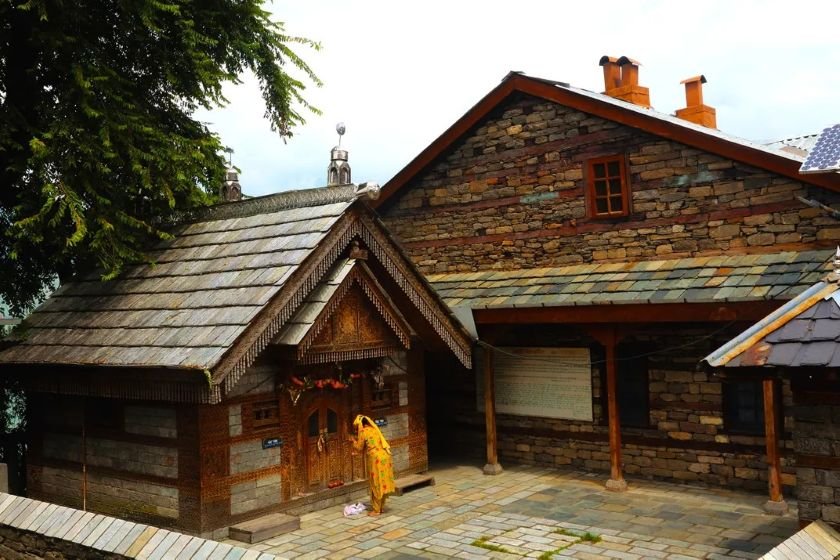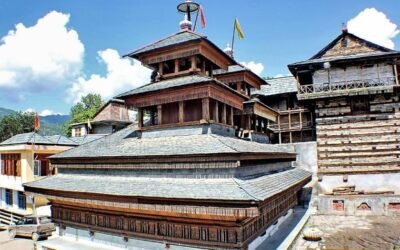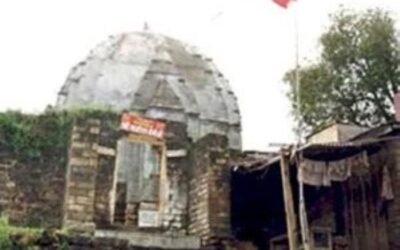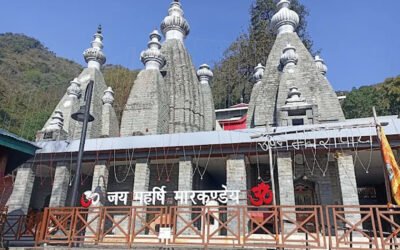Where honeybees carried divinity and the valley listens for guidance
Tucked within the courtyard of the historic Naggar Castle, the Jagatipatt Temple is a sacred and symbolic shrine that holds the soul of the Kullu Valley’s divine order. Unlike conventional temples, it is not defined by idols or rituals alone—but by a mystical stone slab, believed to have been carried by a swarm of honeybees, incarnations of the gods themselves. This temple is the spiritual parliament of the valley, where deities gather in times of crisis and celebration.
🌄 Location & Accessibility
- Location: Inside Naggar Castle, Naggar, Kullu District, Himachal Pradesh – 175130
- Altitude: ~1,800 meters
- By Road: 23 km from Kullu, 21 km from Manali; accessible via taxis or buses
- By Air: Bhuntar Airport (~35 km)
- By Rail: Joginder Nagar (~125 km) or Pathankot (~270 km)
- On Foot: A short walk from Naggar Bus Stand through cobbled village paths
🕉️ Deity & Worship
The temple is dedicated to the sacred Jagati Patt stone, a triangular slab measuring approximately 5x8x6 feet, believed to have been brought from the summit of Deo Tibba or Bhrigu Tung by honeybees in divine form. The stone is revered as a manifestation of collective divinity, and is the seat of spiritual authority for the valley’s deities.
The goddess is worshipped in the form of three pindis, representing Maha Kali, Maha Lakshmi, and Maha Saraswati.
Devotees offer red flags, coconuts, and sweets, and the temple is especially known for fulfilling wishes of childless couples and those seeking justice. During times of natural calamities or major decisions, the Atharah Kardu (eighteen main deities of Kullu) gather here through their Gurs (mediums) to perform rituals and seek divine consensus.
🏛️ Architecture & Setting
The Jagatipatt Temple is a stone-walled sanctum with a triangular wooden roof, nestled within the Naggar Castle’s open courtyard. Its intricately carved wooden doors and beams feature fluid motifs and sacred symbols, while the ceiling panels display traditional Himachali craftsmanship.
The temple’s austere elegance and closed sanctum evoke a sense of mystery and reverence. Visitors often peek through the wooden lattice to glimpse the sacred stone, surrounded by flowers, incense, and offerings.
📜 Mythological Significance
According to legend, when the gods sought a place to anchor divine order in the Kullu Valley, they chose Naggar. The Jagati Patt stone was carried here by bees sent by the deities, and it became the foundation of spiritual governance. Since then, the temple has served as a divine council chamber, where rituals, decisions, and blessings are issued in times of need.
The temple is also linked to the royal lineage of Kullu, and was historically used by the ruling family to consult the gods before major events.
🎉 Festivals & Celebrations
- Sharhi Jatra & Dussehra: The temple plays a symbolic role in the gathering of deities during regional festivals
- Special Rituals: Held during earthquakes, floods, or social unrest, when the devtas are invoked for guidance
- Daily Offerings: Flowers, incense, and sacred chants by local priests and villagers
🏞️ Nearby Attractions
- Tripura Sundari Temple: The tutelary goddess of Naggar, just a short walk uphill
- Naggar Castle: A heritage site with panoramic views and a museum
- Nicholas Roerich Art Gallery: Celebrating the Russian mystic and painter who made Naggar his home
- Gauri Shankar Temple: An ancient Shiva shrine with exquisite stone carvings
🙏 Spiritual Experience
The Jagatipatt Temple is not a place of grand rituals or towering idols—it is a quiet sanctum of cosmic dialogue, where gods once flew as bees and divine decisions are still whispered into wood and stone. As you stand in its shadow, with the wind rustling through cedar beams and the valley stretching below, you feel the weight of sacred silence—a reminder that faith is not always loud, but always present.




